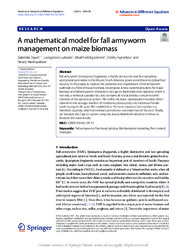| dc.contributor.author | Daudi, Salamida | |
| dc.contributor.author | Luboobi, Livingstone | |
| dc.contributor.author | Kgosimore, Moatlhodi | |
| dc.contributor.author | Kuznetsov, Dmitry | |
| dc.contributor.author | Mushayabasa, Steady | |
| dc.date.accessioned | 2021-02-08T12:38:37Z | |
| dc.date.accessioned | 2021-03-02T06:48:33Z | |
| dc.date.available | 2021-02-08T12:38:37Z | |
| dc.date.available | 2021-03-02T06:48:33Z | |
| dc.date.issued | 2012 | |
| dc.identifier.issn | 1687-1847 | |
| dc.identifier.uri | https://advancesindifferenceequations.springeropen.com/articles/10.1186/s13662-021-03256-5 | |
| dc.identifier.uri | http://moodle.buan.ac.bw:80/handle/123456789/326 | |
| dc.description | © The Author(s) 2021. This article is licensed under a Creative Commons Attribution 4.0 International License, which permits use,
sharing, adaptation, distribution and reproduction in any medium or format, as long as you give appropriate credit to the original
author(s) and the source, provide a link to the Creative Commons licence, and indicate if changes were made. The images or other
third party material in this article are included in the article’s Creative Commons licence, unless indicated otherwise in a credit line
to the material. If material is not included in the article’s Creative Commons licence and your intended use is not permitted by
statutory regulation or exceeds the permitted use, you will need to obtain permission directly from the copyright holder. To view a
copy of this licence, visit http://creativecommons.org/licenses/by/4.0/. | en_US |
| dc.description.abstract | Fall armyworm (Spodoptera frugiperda), a highly destructive and fast spreading agricultural pest native to North and South America, poses a real threat to global food security. In this paper, to explore the dynamics and implications of fall armyworm outbreak in a field of maize biomass, we propose a new dynamical system for maize biomass and fall armyworm interaction via Caputo fractional-order operator, which is not only a nonlocal operator but also contains all characteristics concerned with memory of the dynamical system. We define the basic reproduction number, which represents the average number of newborns produced by one individual female moth during its life span. We establish that the basic reproduction number is a threshold quantity, which determines persistence and extinction of the pest. Finally, we simulate the Caputo system using the Adam–Bashforth–Moulton method to illustrate the main results. | en_US |
| dc.language.iso | en | en_US |
| dc.publisher | SpringerLink | en_US |
| dc.relation.ispartofseries | Advances in Difference Equations;Vol. 99, 2021 | |
| dc.subject | Fall armyworm | en_US |
| dc.subject | Fractional calculus | en_US |
| dc.subject | Mathematical modeling | en_US |
| dc.subject | Pest control strategies | en_US |
| dc.title | A mathematical model for fall armyworm management on maize biomass | en_US |
| dc.type | Article | en_US |

